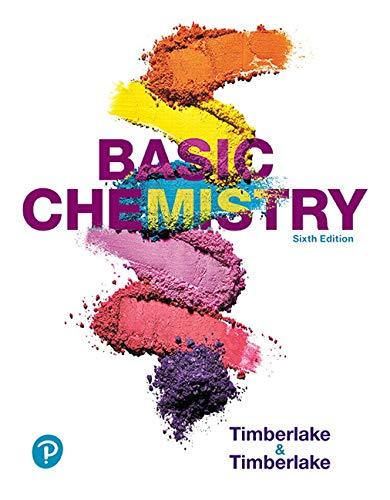
(a)
Interpretation:
Interpret major type of intermolecular forces between BrF.
Concept Introduction:
Intermolecular forces are the forces responsible for the interaction between the neighbouring particles or these are the forces present between the molecules. The name intermolecular indicates the forces present between the atoms or ions.The main intermolecular forces are:
Dipole-dipole forces
These forces are the interaction present between the polar molecules.
London dispersion forces
These forces are the forces known for short term attraction due to unequal distribution of electron.
Hydrogen bond
These forces existbetween hydrogen and the atom which is highly electronegative in nature not directly associated or bonded with it.
(b)
Interpretation:
Interpret major type of intermolecular forces between KCl.
Concept Introduction:
Intermolecular forces are the forces responsible for the interaction between the neighbouring particles or these are the forces present between the molecules. The name intermolecular indicates the forces present between the atoms or ions. The main intermolecular forces are:
Dipole-dipole forces
These forces are the interaction present between the polar molecules.
London dispersion forces
These forces are the forces known for short term attraction due to unequal distribution of electron.
Hydrogen bond
These forces exist between hydrogen and the atom which is highly electronegative in nature not directly associated or bonded with it.
(c)
Interpretation:
Interpret major type of intermolecular forces between NF3.
Concept Introduction:
Intermolecular forces are the forces responsible for the interaction between the neighbouring particles or these are the forces present between the molecules. The name intermolecular indicates the forces present between the atoms or ions. The main intermolecular forces are:
Dipole-dipole forces
These forces are the interaction present between the polar molecules.
London dispersion forces
These forces are the forces known for short term attraction due to unequal distribution of electron.
Hydrogen bond
These forces exist between hydrogen and the atom which is highly electronegative in nature not directly associated or bonded with it.
(d)
Interpretation:
Interpret major type of intermolecular forces between Cl2.
Concept Introduction:
Intermolecular forces are the forces responsible for the interaction between the neighbouring particles or these are the forces present between the molecules. The name intermolecular indicates the forces present between the atoms or ions. The main intermolecular forces are:
Dipole-dipole forces
These forces are the interaction present between the polar molecules.
London dispersion forces
These forces are the forces known for short term attraction due to unequal distribution of electron.
Hydrogen bond
These forces existbetween hydrogen and the atom which is highly electronegative in nature not directly associated or bonded with it.
Want to see the full answer?
Check out a sample textbook solution
Chapter 10 Solutions
Basic Chemistry Plus Mastering Chemistry With Pearson Etext -- Access Card Package (6th Edition)
- 2. Provide reagents/conditions to accomplish the following syntheses. More than one step is required in some cases. a. CH3arrow_forwardIdentify and provide an explanation that distinguishes a qualitative and quantitative chemical analysis. Provide examples.arrow_forwardIdentify and provide an explanation of the operational principles behind a Atomic Absorption Spectrometer (AAS). List the steps involved.arrow_forward
- Instructions: Complete the questions in the space provided. Show all your work 1. You are trying to determine the rate law expression for a reaction that you are completing at 25°C. You measure the initial reaction rate and the starting concentrations of the reactions for 4 trials. BrO³¯ (aq) + 5Br¯ (aq) + 6H* (aq) → 3Br₂ (l) + 3H2O (l) Initial rate Trial [BrO3] [H*] [Br] (mol/L) (mol/L) | (mol/L) (mol/L.s) 1 0.10 0.10 0.10 8.0 2 0.20 0.10 0.10 16 3 0.10 0.20 0.10 16 4 0.10 0.10 0.20 32 a. Based on the above data what is the rate law expression? b. Solve for the value of k (make sure to include proper units) 2. The proposed reaction mechanism is as follows: i. ii. BrО¸¯ (aq) + H+ (aq) → HBrO3 (aq) HBrO³ (aq) + H* (aq) → H₂BrO3* (aq) iii. H₂BrO³* (aq) + Br¯ (aq) → Br₂O₂ (aq) + H2O (l) [Fast] [Medium] [Slow] iv. Br₂O₂ (aq) + 4H*(aq) + 4Br(aq) → 3Br₂ (l) + H2O (l) [Fast] Evaluate the validity of this proposed reaction. Justify your answer.arrow_forwardе. Д CH3 D*, D20arrow_forwardC. NaOMe, Br Brarrow_forward
- Please predict the products for each of the following reactions: 1.03 2. H₂O NaNH, 1. n-BuLi 2. Mel A H₂ 10 9 0 H2SO4, H₂O HgSO4 Pd or Pt (catalyst) B 9 2 n-BuLi ♡ D2 (deuterium) Lindlar's Catalyst 1. NaNH2 2. EtBr Na, ND3 (deuterium) 2. H₂O2, NaOH 1. (Sia)2BH с Darrow_forwardin the scope of ontario SCH4U grade 12 course, please show ALL workarrow_forwardIs the chemical reaction CuCl42-(green) + 4H2O <==> Cu(H2O)42+(blue) + 4Cl- exothermic or endothermic?arrow_forward
 Chemistry for Engineering StudentsChemistryISBN:9781337398909Author:Lawrence S. Brown, Tom HolmePublisher:Cengage Learning
Chemistry for Engineering StudentsChemistryISBN:9781337398909Author:Lawrence S. Brown, Tom HolmePublisher:Cengage Learning Introductory Chemistry: A FoundationChemistryISBN:9781337399425Author:Steven S. Zumdahl, Donald J. DeCostePublisher:Cengage Learning
Introductory Chemistry: A FoundationChemistryISBN:9781337399425Author:Steven S. Zumdahl, Donald J. DeCostePublisher:Cengage Learning

